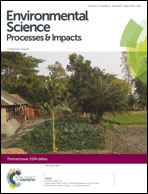Export of radioactive cesium from agricultural fields under simulated rainfall in Fukushima†
Abstract
In this study, we investigated the impact of rainfall on runoff, soil erosion and consequently on the discharge of radioactive cesium in agricultural fields in Fukushima prefecture using a rainfall simulator. Simulated heavy rainfalls (50 mm h−1) generated significant runoff and soil erosion. The average concentration of radioactive cesium (the sum of 134Cs and 137Cs) in the runoff sediments was ∼3500 Bq kg−1 dry soil, more than double the concentrations measured in the field soils which should be considered in studies using the 137Cs loss to estimate long-term soil erosion. However, the estimated mass of cesium discharged through one runoff event was less than 2% of the cesium inventory in the field. This suggested that cesium discharge via soil erosion is not a significant factor in reducing the radioactivity of contaminated soils in Fukushima prefecture. However, the eroded sediment carrying radioactive cesium will deposit into the river systems and potentially pose a radioactivity risk for aquatic living organisms.


 Please wait while we load your content...
Please wait while we load your content...